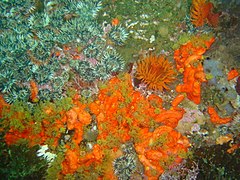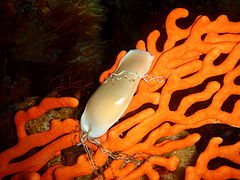Castor Rock is an offshore rocky reef with some named dive sites in the Simon's Bay area on the Cape Peninsula side of False Bay, near Cape Town in the Western Cape province of South Africa.
Understand
edit
Castor Rock is close to the launch site at False Bay Yacht Club and the Simon's Town jetty, and is relatively sheltered from southwesterly swell. The site is shallow and suited to entry level divers, but has areas of high profile scenic topography.
Position
edit- 1 Central Pinnacle: S34°10.720’ E018°27.605’ (7m) The nominal mark for Castor Rock – An extensive area of rocky reef north of Roman Rock lighthouse with several pinnacles.
This site is in the Table Mountain National Park Marine Protected Area (2004). A permit is required. The site is mostly inside the Boulders Restricted Zone.
Name
editThe area is shown on SA Navy charts as "Castor Rock".
Depth
editMaximum depth is about 18 m to the south, and 22 m to the north. The highest point on the reef is about 7 m deep. There are a few other pinnacles above 12 m.
Visibility
editVisibility can be expected to be similar to Roman Rock
Topography
editThis is an extensive reef of granite. Basically a large area of moderate to low outcrops with occasional high areas, small gullies, ridges, boulders, small crevices and overhangs. The edge of the reef is penetrated at irregular intervals by small sandy bottomed gullies between the ridges.
The reef is divided into two large lobes by a pair of narrow sand tongues which encroach into the reef from the east and west, and nearly meet just north of Wonders Pinnacle on the west side of the south lobe.
The northern lobe is Castor Reef proper, and is more compact and substantial overall than the southern lobe. The edges are also penetrated by gullies, but to a lesser extent. The northern end is relatively flat and slopes gradually down to the sand, but the eastern and western sides are more ruggedly profiled. Castor rock reef north lobe has a very different character to Roman and Rambler rocks. The reef top is of moderate relief, with relatively shallow sandy gullies, small overhangs and boulders, and has some steep areas at the edges. The sand to the south is coarse and shelly in places.
The southern lobe is longer and narrower than the north lobe, and has an area of pinnacles at each end. The reef between is lower and somewhat broken along the edges. This lobe is also known as Wonders Reef.
The western pinnacle is Wonders Pinnacle, and the eastern area is Roman's Rest pinnacles. The main pinnacle of Roman's Rest is a huge outcrop rising from the sand to just above 12 m at the top, very steep on the north east side, and with several deep round bottomed indentations. The east side is also pretty steep, but the south west side is more gradually sloped and the north west side steps down towards a pair of lesser pinnacles to the north west. These are huge boulders standing on a flattish rock base at about 20 m depth and rising to about 12 m at the top. One of them is relatively narrow for its height, about 5 m one way and about 7 or 8 m the other way, and is about 8 m high and pointed on top. The other is wider and a bit lower, but they make an impressive pair. They can be seen from the edge of the sand tongue in reasonable visibility.
There are occasional low outliers around the east end of the reef near the pinnacle.
Castor reef has several other reefs nearby which are known as good dive sites, These include Roman Rock, Tivoli Pinnacles, Friskies Pinnacle and the Rambler Rock reefs.
Geology: Granite corestone outcrops and boulders of the late Pre-Cambrian Peninsula pluton.
Conditions
editThe site is exposed to winds from all directions, which can produce an unpleasant choppy sea, and make it difficult for the boat crew to see a diver on the surface. Generally considered a winter dive, as this is when conditions are most likely to be good, but can be dived any time the swell is low and the visibility is acceptable. This can happen any time of the year after a period of light winds when the swell is low or short period.
Get in
editAlways dived from a boat. The site is 3.3 km from Simon's Town jetty, or 5.6 km from Miller's Point slipway.
Do
editDive at one of the drop points and explore the vicinity, or follow one of the suggested routes.
North lobe:
1 Castor Rock - Northern Pinnacle: S34°10.690’ E018°27.590’ (5m). There is a high profile outlier reef section a few metres across the sand to the north of the main reef known as Northern Pinnacle, which is a good site with impressive topography, comprising a tall steep pinnacle with overhangs and swim-throughs. The main reef edge can be seen from the Northern Pinnacle reef on a good day. This site is small enough to be comprehensively explored on a single dive, but is pretty enough to return to several times.
2 Castor Rock - Central Pinnacle: S34°10.720’ E018°27.605’ (7m) The pinnacle to the north east of the contiguous reef is Castor Rock (Central) pinnacle, which is a locally shallow area with a steep drop to the sand on the north east face, and more gradual slope to the reef top on the other sides.
3 Castor Rock - Southwest Pinnacle: S34°10.765’ E018°27.650’ (7m) The high point of an area of local high profile reef on the eastern edge of the north lobe.
4 Castor Rock - Southeast Pinnacle: S34°10.765’ E018°27.600’ (9m) A locally shallow area on the southern part of the north lobe. More of a marker for the surrounding area than a specific destination.
South lobe:
5 Wonders Pinnacle: S34°10.812’ E018°27.650’. (8m) Drop off at the pinnacle, dive the surrounding reef and ascend at the pinnacle. This is a relatively small area, but enough for a good dive.
6 Roman's Rest: S34°10.831’ E018°27.802’. (10m) Drop off at the pinnacle, visit the twin pinnacles, explore the reef and ascend at the pinnacle. This is a small area, but enough for a good dive. If you have time to spare, it is not very far to the western reef section near Wonders Pinnacle.
Routes
edit- Main Reef: Drop off over the main reef and work your way down to the sand, then back up to one of the pinnacles if the surge is not too strong.
- North Pinnacle: Either drop off over the North Pinnacle, or at the northern pinnacle of the main reef, and swim north over the sand to the North Pinnacle. After the dive either shoot a DSMB and ascend, or swim back across the sand to the south and ascend at the northern pinnacle of the main reef.
See
editMarine life
editLarge variety of invertebrates, and if you do your safety stop near one of the pinnacles you may be visited by shoals of reef fish including Hottentot, Galjoen, Dassie and Fransmadam. Relatively large numbers of Bank steenbras have been seen here, but mostly quite small. Zonation is variable according to depth and surface orientation. Some kelp above about 10 m, but small and sparse. Red bait and other large ascidians fairly numerous, but not densely packed. There are patches of encrusting sponges and ascidians on relatively horizontal areas. Moderate numbers of elegant feather stars are scattered around. Common feather stars are also common in some areas, mostly where it is fairly steeply sloped. There are also clumps of red chested cucumbers, mauve cucumbers, striped anemones, Stephens' codium (relatively shallow), bushy corallines, encrusting corallines and Coral plocamium.
There are lots of gorgonian sea fans along the reef edges in the 15 m to 20 m depth range. Palmate, Sinuous, and Flagellar fans appear to be equally common. There are huge numbers of golden sea cucumbers on the reef slopes to the north and more expectedly, also in the sand along the reef margins. Occasioanally virtual carpets of hairy brittle stars can be seen at the north end of the reef.
- Leopard catshark
- Scorpion fish
- Shoal of Galjoen
- Reef scene with green soft corals
- Red cucombers and Striped anemones
- Shy shark
- Catshark egg case on a sinous sea fan
- Sea fan covered by hairy brittle stars
- Reef cover of golden sea cucumbers
Features
editPhotography
editGood photographic site. Most equipment will be usable depending on visibility.
Stay safe
editHazards
editGreat white sharks have been seen in the vicinity.
Skills
editNo special skills required, though the ability to deploy a DSMB is useful in case you are separated from the group or need to surface away from the shot line.
Equipment
editA light is useful to restore colour at depth, a compass to keep track of your movements, and a DSMB will let the boat know where you are when surfacing.
Nearby
edit- 1 Livingstone Reef
- 2 Target Reef
- 3 Friskies Pinnacle
- 4 Roman Rock
- 5 Tivoli Pinnacles
- 6 Rambler Rock Southern pinnacles
- 7 Dome Rock
- 8 Noah’s Ark - Twin barges
- 9 Phoenix shoal
- 10 Ammunition Barges
Back to the Alphabetical list of sites, or list of dive sites in the Roman Rock area
Other regional dive sites:
- Dive sites of Table Bay and approaches,
- Dive sites of the Cape Peninsula west coast
- Dive sites of False Bay offshore and approaches
- Dive sites of False Bay east coast
- Fresh water dive sites of the Cape Town Metropolitan Area












